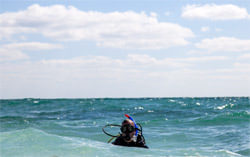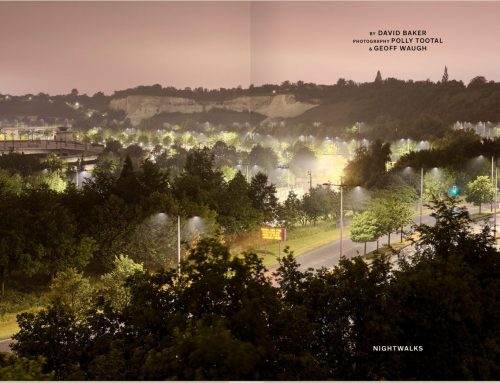Six years ago, an underwater panic attack ended David Baker’s love affair with diving. Could he really train to be a divemaster?
Financial Times magazine, February 28 2014
It started with a scary moment. In August 2008, I was diving off the Red Sea coast at Dahab when, 30 metres underwater, I was overwhelmed by panic. The water there is famously clear and, as my dive group emerged from the descent of a cylindrical shaft in the rock, all I could see was blue stretching infinitely away in every direction. I was at the back of the group and, as the other divers moved off, I suddenly felt tiny, lost and alone. My heart was beating too fast, I started to hyperventilate and I was sure, in this stunningly beautiful setting, that I was going to drown.There was, of course, no real danger. But that kind of reasoning doesn’t reach the primal part of the brain and it took considerable coaxing and reassurance from the divemaster to calm me down.
Panics are usually one-off events. But over the next few days, each time I tried to dive, I found that the water, which had been my friend for most of my life, was now a terrifying enemy. With sadness, I decided my diving days were over.
Then, just over a year ago, I was holidaying in Tulum on Mexico’s Caribbean coast and killing time waiting for some friends. Suddenly a sign for a dive shop caught my eye. I wandered up to the little shack on the beach marked Quelonian Divers. The next thing, I was talking to an instructor about taking a gentle refresher dive.
Diving can sometimes be a macho world and it’s surprising how little some people want to talk about fear – but at that tiny dive shop I met an instructor, Pablo Perotti, who had no such hang-ups. I signed up for more. Over a series of seven dives, he helped me see the beauty of diving again. That was when I decided to face my anxieties head on by training to be a divemaster.
My initial impetus was, at least partly, hedonistic. Tulum is a magical place and I wanted to find a way of coming back for two months of sun while London shivered. A divemaster course would be the perfect excuse. But, as I looked into it, I realised it also came with some additional challenges. The work would be mainly physical. Was I strong enough (or, at 48 then, young enough) to pull it off? Would I be able to keep my London work going, 5,000 miles away, using just the internet? Could I settle into a new place fast enough to make the two months worthwhile? As part of my training, I would be working for the dive shop as an intern, so what would it be like to be the most junior person in an organisation?
I found myself more excited than appalled at these prospects so, back in London, I booked a ticket to return to Tulum in the middle of January 2013 until mid-March.
My first few days were inauspicious. It proved hard to find somewhere to live and the weather was poor. When I showed up on the beach for my first morning’s training, the sea was rough and angry-looking, nothing like the azure pond I had left behind. But this led to what turned out to be a very good first lesson in surviving outside your comfort zone.
Perotti had assigned to me an affable, thirtysomething instructor called Tullio Divona. My first task, after a coffee (Divona is Italian) and some getting-to-know-each-other chat, was to swim 800 metres under a certain time – something, he told me, “even a monkey” could do. I waded in but as soon as I felt the water splash over me, colder now and somehow more hostile, I realised what I had got myself into. I began to swim but, unfit after a London winter, I thrashed around and quickly exhausted myself. After about 100 metres I hurried out of the sea, convinced I had made a terrible mistake.
Divona sent me back in again to finish the swim with barely a shrug. And, of course, I could do it. Things are easier if someone else is forcing you to do them.
We talked afterwards about the experience and Divona set me the first of many tasks – to spend a full hour of each day in the sea – on top of the diving practice we would be doing. He was easy-going about it – “I don’t care if you spend 20 minutes floating on your back,” he said – but he stressed the need to make the sea my environment, “to get water in your mouth, up your nose, to realise that it’s not so bad”. And, indeed, to be pushed through my reluctance like that worked. Soon I was understanding the waves and water, and, crucially, enjoying them again.
It turned out that I had only really needed to swim 400 metres on that first task, but Divona liked to make things harder. It was a trait I found attractive. As the weeks went on, we often sought out turbulent sea conditions in which to dive, even though we could have practised somewhere calmer. His attitude, which became mine, was, “If you can do it in this, you can do it anywhere.”
To qualify in this jack-of-all-trades role, you have to know a fair bit about pretty much everything. You’re tested on a lot of theory – physics and physiology, biology (marine and human), first aid and life-saving, equipment maintenance and the business of running a dive shop – and there are official exams and practical tests that are set by the worldwide Professional Association of Diving Instructors. But the real learning was being part of Perotti’s dive operation, diving with customers, helping out behind the scenes and walking the beach trying to make sales.
I was expected to work a full day, six days a week. And, for someone whose main daytime activity is usually sitting at a computer and typing, the work was hard. As the junior (or “slave”, as you are inevitably but lovingly known), you are often the one who has to load all the equipment and air tanks, which weigh 20kg each, into the truck, carry spares in case anything breaks during a dive, run to get towels for the customers and wash everything when you are back at base.
I thought I might resent this – I was easily the oldest person in the company – but, in fact, this aspect of the training was the most stimulating. I liked being told what to do: seniority and the autonomy that comes with it can be tiring after a while. I also liked showing initiative and starting projects of my own. I got fitter and discovered a love of manual work, which I didn’t know I had. And I became more relaxed, passing the time when not much was happening in a kind of reverie, something I don’t often allow myself in my white-collar working time in London.
All this had totally distracted me from my initial anxieties about going underwater. Which was why it was important when they reappeared.
In Tulum, the diving takes place mostly in cenotes, inland underwater caverns that are part of the Yucatán’s underground river system. You come across caves full of stalactites and stalagmites, formed when the sea level was lower. The contrast of light and dark is stunning and, especially near the coast, you see a fascinating mix of fresh and seawater marine life.
But cenotes have an extra, scary element over diving in the sea – you are often swimming under rock. This shouldn’t really make any difference. In any diving you are not meant to ascend immediately to the surface if you get alarmed – unless you come up very slowly, in stages, you risk getting the bends, which is far more serious than it sounds. But at least in the sea you have the psychological reassurance that there is air and light above you. In cenotes, sometimes all that is above you is black rock, and it was during one of these moments, diving with some customers in a cenote called Tajma Ha, that I felt my old panic coming back. I was again at the back of the group and, as we passed through a particularly dark and daunting cavern, I had an exact repeat of the panic I experienced in Dahab. But this time, by contrast, I didn’t need rescuing.
Something had developed inside me, a new sense of independence and self-reliance as a diver. And I used it to rescue myself. I calmed my own breathing, just as the Dahab divemaster had done. I relaxed until my heart went back to normal. And I felt the adrenalin melting away. All this took maybe half a minute and, of course, no one else noticed what was going on. But I found myself smiling. In a small, private moment, I had passed my own personal rite of passage. Dahab had been conquered.
David’s tips
Make yourself experience small doses of diving practice that you find challenging – if possible, on a daily basis.
Take baby steps: small experiments, which, if they go wrong, are not going to be a disaster. Look for worse diving conditions than you would usually expect and give them a go.
Seek out unfamiliar situations – this will make you more comfortable with being pushed. In my case, it was being the most junior person in the organisation.
Being a divemaster is to set your foot on the first rung of professional diving. The divemaster is the person who sets up your equipment for you while you’re still having breakfast. They take you out on a dive and make sure everyone is safe and having a good time. They get to use only whatever wetsuits and equipment are left over after the customers have been kitted out – I often dived in an extra-large wetsuit bulked out by a skintight small one underneath. And they assist the instructors helping people learn new skills.






